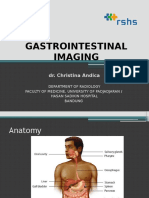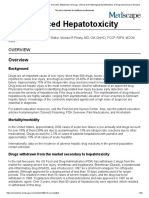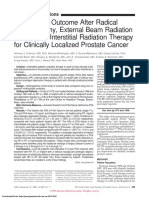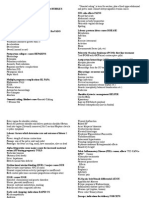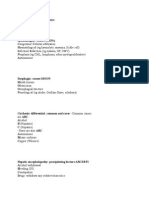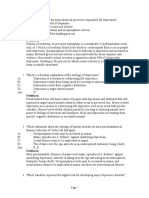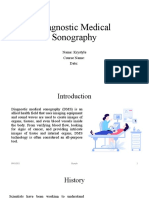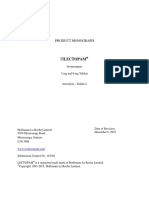Dwarfism: Needed)
Dwarfism: Needed)
Uploaded by
Annapurna DangetiCopyright:
Available Formats
Dwarfism: Needed)
Dwarfism: Needed)
Uploaded by
Annapurna DangetiOriginal Description:
Original Title
Copyright
Available Formats
Share this document
Did you find this document useful?
Is this content inappropriate?
Copyright:
Available Formats
Dwarfism: Needed)
Dwarfism: Needed)
Uploaded by
Annapurna DangetiCopyright:
Available Formats
Cretinism
Cretinism is a condition of severely stunted physical and mental growth due to
untreated congenital defciency of thyroid hormones (congenital hypothyroidism) usually
due to maternal hypothyroidism.
Etymology and use of cretin
The term cretin is a medical term which describes a person so afected with the
condition, but, as with words such as spastic and lunatic, it can also have a vulgar
connotation and can be used disparagingly. Cretin became a medical term in the 18th
century, from an lpine !rench dialect" it saw wide medical use in the 1#th and early
$%th centuries, and then spread more widely in popular &nglish as a mar'edly
derogatory term for a person who behaves stupidly. (ecause of its pe)orative
connotations in popular speech, health*care wor'ers have mostly abandoned cretin.
+citation
needed,
-ther speculative etymologies have been ofered.
!rom creta, /atin for chalk, because of the pallor of those afected.
!rom 01rete0, where iodine insu2ciency (3ypothyroidism) was common prior to the
modern era.+1,
!rom cretira, 4risson*5omance creature, from /atin creatus.
!rom cretine, !rench for alluvium (soil deposited by 6owing water), an allusion to
the a7iction8s suspected origin in inade9uate soil.
+1,
!rom 0chretien,0 !rench for 01hristian0 or 01hristli'e,0 because those afected were
so mentally handicapped that they were considered incapable of sinning
+$,
Sporadic cretinism due to congenital hypothyroidism
1ongenital hypothyroidism can be endemic, genetic, or sporadic. :f untreated, it results
in mild to severe impairment of both physical and mental growth and development.
;oor length growth is apparent as early as the frst year of life. dult stature without
treatment ranges from 1 to 1.< metres (=8> to ?8=), depending on severity, se@ and other
genetic factors. (one maturation and puberty are severely delayed. -vulation is
impeded and infertility is common.
Dwarfsm
Dwarfsm is a condition of short stature. :t is defned by the advocacy group /ittle
;eople of merica (/;) as an adult height of > feet 1% inches or under, as a result of a
medical or genetic condition. lthough other groups may e@tend the criteria for certain
forms of dwarfsm to ? feet, the average height of an adult with dwarfsm is > feet.
There are two main categories of dwarfsm ** disproportionate and proportionate.
Aisproportionate dwarfsm is characteriBed by an average*siBe torso and shorter arms
and legs or a shortened trun' with longer limbs. :n proportionate dwarfsm, the body
parts are in proportion but shortened.
Dwarfsm Causes
Awarfsm can be caused by any of more than $%% conditions. 1auses of proportionate
dwarfsm include metabolic and hormonal disorders such as growth hormone defciency.
The most common types of dwarfsm, 'nown as s'eletal dysplasias, are genetic. C'eletal
dysplasias are conditions of abnormal bone growth that cause disproportionate dwarfsm.
They include.
Achondroplasia. The most common form of dwarfsm, achondroplasia occurs in about
one out of $<,%%% to >%,%%% babies and is evident at birth. ;eople with achondroplasia
have a relatively long trun' and shortened upper parts of their arms and legs. -ther
features of achondroplasia include.
a large head with a prominent forehead
a 6attened bridge of the nose
protruding )aw
crowded and misaligned teeth
forward curvature of the lower spine
bowed legs
6at, short, broad feet
0double*)ointedness0
Spondyloepiphyseal dysplasias (SED). less common form of dwarfsm, C&A afects
appro@imately one in #?,%%% babies. Cpondyloepiphyseal dysplasia refers to a group of
conditions characteriBed by a shortened trun', which may not become apparent until a
child is between ? and 1% years old. -ther features can include.
club feet
cleft palate
severe osteoarthritis in the hips
wea' hands and feet
barrel*chested appearance
Diastrophic dysplasia. rare form of dwarfsm, diastrophic dysplasia occurs in about
one in 1%%,%%% births. ;eople who have it tend to have shortened forearms and calves
(this is 'nown as mesomelic shortening).
-ther signs can include
deformed hands and feet
limited range of motion
cleft palate
ears with a cauli6ower appearance
Dwarfsm Genetics
C'eletal dysplasia is caused by a genetic mutation. The gene mutation can occur
spontaneously or can be inherited.
Aiastrophic dysplasia and usually spondyloepiphyseal dysplasias are inherited in a
recessive manner. This means a child must receive two copies of the mutated gene **
one from the mother, one from the father ** to be afected.
chondroplasia, on the other hand, is inherited in a dominant manner. That means a
child needs only one copy of the mutated gene to have that form of s'eletal dysplasia.
There is a $?D chance that a child born to a couple in which both members have
achondroplasia will be of normal height. (ut there is also a $?D chance the child will
inherit both dwarfsm genes, a condition 'nown as double*dominant syndrome. This is a
fatal condition that usually results in miscarriage.
-ften parents of children with achondroplasia do not carry the mutated gene
themselves. The mutation in the child occurs spontaneously at the time of conception.
Aoctors do not 'now what causes a gene to mutate. :t is a seemingly random occurrence
that can happen in any pregnancy. Ehen average*siBe parents have a child with
dwarfsm due to a spontaneous mutation, it is not li'ely that other children will also have
the mutation.
:n addition to genetic s'eletal dysplasia, short stature has other causes, including
disorders of the pituitary, which in6uence growth and metabolism" 'idney disease" and
problems that afect the body8s ability to absorb nutrients.
Dwarfsm Diagnosis
Come forms of dwarfsm are evident at birth or during infancy and can be diagnosed
through F*rays and a physical e@am. diagnosis of achondroplasia, diastrophic
dysplasia, or spondyloepiphyseal dysplasia can be confrmed through genetic testing. :n
some cases, prenatal testing is done if there is concern for specifc conditions.
Cometimes dwarfsm doesn8t become evident until later in a child8s life, when dwarfsm
signs lead parents to see' a diagnosis. 3ere are signs and symptoms to loo' for in
children that indicate a potential for dwarfsm.
late development of certain motor s'ills, such as sitting up or wal'ing
increased susceptibility to ear infections
breathing problems
weight problems
curvature of the spine
bowed legs
)oint stifness and arthritis
lower bac' pain or numbness in the legs
crowding of teeth
Dwarfsm Treatments
&arly diagnosis and treatment can help prevent or lessen some of the problems
associated with dwarfsm. ;eople with dwarfsm related to growth hormone defciency
can be treated with growth hormone.
:n many cases, people with dwarfsm have orthopaedic or medical complications.
Treatment of those can include.
:nsertion of a shunt to drain e@cess 6uid and relieve pressure on the brain.
tracheotomy to improve breathing through small airways.
1orrective surgeries for deformities such as cleft palate, club foot, or bowed legs.
Curgery to remove tonsils or adenoids to improve breathing problems related to
large tonsils, small facial structures, andGor a small chest.
Curgery to widen the spinal canal (the opening through which the spinal cord
passes) to relieve spinal cord compression.
-ther treatment may include.
;hysical therapy to strengthen muscles and increase )oint range of motion.
(ac' braces to improve curvature of the spine.
;lacement of draining tubes in the middle ear to help prevent hearing loss due to
repeated ear infections.
-rthodontic treatment to relieve crowding of teeth caused by a small )aw.
Hutritional guidance and e@ercise to help prevent obesity, which can aggravate
s'eletal problems.
Gigantism
4igantism is abnormal growth due to an e@cess of growth hormone during childhood.
Causes
The most common cause of too much growth hormone release is a noncancerous
(benign) tumor of the pituitary gland. -ther causes include.
1arney comple@
Ic1une*lbright syndrome (IC)
Iultiple endocrine neoplasia type 1 (I&H*1)
Heurofbromatosis
:f e@cess growth hormone occurs after normal bone growth has stopped, the condition is
'nown as acromegaly.
4igantism is very rare.
Symptoms
The child will grow in height, as well as in the muscles and organs. This e@cessive growth
ma'es the child e@tremely large for his or her age.
-ther symptoms include.
Aelayed puberty
Aouble vision or di2culty with side (peripheral) vision
!rontal bossing and a prominent )aw
4aps between the teeth
3eadache
:ncreased sweating
:rregular periods (menstruation)
/arge hands and feet with thic' fngers and toes
5elease of breast mil'
Cleep problems
Thic'ening of the facial features
Eea'ness
Exams and Tests
The doctor will perform a physical e@am and as' about the child8s symptoms.
/aboratory tests that may be ordered include.
1ortisol
&stradiol (girls)
4rowth hormone suppression test
;rolactin
:ncreased growth factor*:
Testosterone (boys)
Thyroid hormone
:maging tests, such as 1T or I5: scan of the head, also may be ordered to chec' for a
pituitary tumor.
Treatment
!or pituitary tumors with well*defned borders, surgery can cure many cases.
Ehen surgery cannot completely remove the tumor, medicines are used to bloc' or
reduce growth hormone release.
Outlook (Prognosis)
;ituitary surgery is usually successful in limiting growth hormone production.
&arly treatment can reverse many of the changes caused by growth hormone e@cess.
Possible Complications
Curgery may lead to low levels of other pituitary hormones, which can cause.
drenal insu2ciency
Aiabetes insipidus (rarely)
3ypogonadism
3ypothyroidism
When to Contact a Medical Proessional
1all your health care provider if your child has signs of e@cessive growth.
!lternati"e #ames
4iantism" ;ituitary giant
steomalacia
-steomalacia is softening of the bones due to a lac' of vitamin A or a problem with the
body8s ability to brea' down and use this vitamin.
Causes
The softer bones in osteomalacia have a normal amount of collagen, which gives the
bones its structure. 3owever, they lac' the proper amount of calcium.
There are many causes of osteomalacia. :n children, the condition is called ric'ets and is
usually caused by low levels of vitamin A.
-ther conditions that may lead to osteomalacia include.
Hot enough vitamin A in the diet
Hot enough e@posure to sunlight, which produces vitamin A in the body
Ialabsorption of vitamin A by the intestines
!actors that reduce formation of vitamin A in the body include.
3aving very little e@posure to sunlight
Chorter days of sunlight
Cmog
Jsing very strong sunscreen
The elderly and people who do not drin' mil' are at increased ris' for osteomalacia.
-ther conditions that may cause osteomalacia include.
1ancer
Aisorders of vitamin A metabolism
Kidney failure and acidosis
/ac' of enough phosphates in the diet
/iver disease
Cide efects of medications used to treat seiBures
Symptoms
(one fractures that happen without a real in)ury
Iuscle wea'ness
Eidespread bone pain, especially in the hips
Cymptoms may also occur due to low calcium levels. These include.
Humbness around the mouth
Humbness of the arms and legs
Cpasms of the hands or feet
Exams and Tests
(lood tests will be done to chec' vitamin A, creatinine, calcium, and phosphate
levels.
(one biopsy will show bone softening.
(one @*rays and a bone density test can help detect pseudofractures, bone loss,
and bone softening.
-ther tests may be done to fnd out if a 'idney problem or other disorder is causing the
problem. These tests include.
/; (al'aline phosphatase) isoenByme
;T3
Treatment
Treatment may involve vitamin A, calcium, and phosphorus supplements ta'en by
mouth. ;eople who cannot properly absorb nutrients through the intestines may need
larger doses of vitamin A and calcium.
;eople with certain conditions may need regular blood tests to monitor blood levels of
phosphorus and calcium.
Outlook (Prognosis)
Come people with vitamin defciency disorders will see improvement within a few wee's.
Lou should heal completely with treatment in about < months.
Possible Complications
Cymptoms can return.
When to Contact a Medical Proessional
1all for an appointment with your health care provider if you have symptoms of
osteomalacia, or if you thin' that you may be at ris' for this disorder.
Pre"ention
&ating a diet rich in vitamin A and getting plenty of sunlight can help prevent
osteomalacia due to a vitamin A defciency.
steoporosis
-steoporosis causes bones to become wea' and brittle M so brittle that a fall or even
mild stresses li'e bending over or coughing can cause a fracture. -steoporosis*related
fractures most commonly occur in the hip, wrist or spine.
(one is living tissue, which is constantly being absorbed and replaced. -steoporosis
occurs when the creation of new bone doesn8t 'eep up with the removal of old bone.
-steoporosis afects men and women of all races. (ut white and sian women M
especially those who are past menopause M are at highest ris'. Iedications, healthy diet
and weight*bearing e@ercise can help prevent bone loss or strengthen already wea'
bones.
Causes
bones are in a constant state of renewal M new bone is made and old bone is bro'en
down. Ehen you8re young, your body ma'es new bone faster than it brea's down old
bone and your bone mass increases. Iost people reach their pea' bone mass by their
early $%s. s people age, bone mass is lost faster than it8s created.
3ow li'ely you are to develop osteoporosis depends partly on how much bone mass you
attained in your youth. The higher your pea' bone mass, the more bone you have 0in the
ban'0 and the less li'ely you are to develop osteoporosis as you age.
$iskactors
number of factors can increase the li'elihood that you8ll develop osteoporosis M
including your age, race, lifestyle choices, and medical conditions and treatments.
!nchangea"le ris#s
Come ris' factors for osteoporosis are out of your control, including.
$our se%. Eomen are much more li'ely to develop osteoporosis than are men.
Age. The older you get, the greater your ris' of osteoporosis.
&ace. Lou8re at greatest ris' of osteoporosis if you8re white or of sian descent.
'amily history. 3aving a parent or sibling with osteoporosis puts you at greater
ris', especially if you also have a family history of hip fractures.
'rame si(e. Ien and women who have small body frames tend to have a higher
ris' because they may have less bone mass to draw from as they age.
)ormone le*els
-steoporosis is more common in people who have too much or too little of certain
hormones in their bodies. &@amples include.
Se% hormones. The reduction of estrogen levels at menopause is one of the
strongest ris' factors for developing osteoporosis. Eomen may also e@perience a
drop in estrogen during certain cancer treatments. Ien e@perience a gradual
reduction in testosterone levels as they age. nd some treatments for prostate
cancer reduce testosterone levels in men. /owered se@ hormone levels tend to
wea'en bone.
Thyroid pro"lems. Too much thyroid hormone can cause bone loss. This can
occur if your thyroid is overactive or if you ta'e too much thyroid hormone
medication to treat an underactive thyroid.
ther glands. -steoporosis has also been associated with overactive parathyroid
and adrenal glands.
Dietary factors
-steoporosis is more li'ely to occur in people who have.
+ow calcium inta#e. lifelong lac' of calcium plays a ma)or role in the
development of osteoporosis. /ow calcium inta'e contributes to diminished bone
density, early bone loss and an increased ris' of fractures.
Eating disorders. ;eople who have anore@ia are at higher ris' of osteoporosis.
/ow food inta'e can reduce the amount of calcium ingested. :n women, anore@ia
can stop menstruation, which also wea'ens bone.
Gastrointestinal surgery. reduction in the siBe of your stomach or a bypass or
removal of part of the intestine limits the amount of surface area available to
absorb nutrients, including calcium.
Steroids and other medications
/ong*term use of corticosteroid medications, such as prednisone and cortisone,
interferes with the bone*rebuilding process. -steoporosis has also been associated with
medications used to combat or prevent.
CeiBures
Aepression
4astric re6u@
1ancer
Transplant re)ection
+ifestyle choices
Come bad habits can increase your ris' of osteoporosis. &@amples include.
Sedentary lifestyle. ;eople who spend a lot of time sitting have a higher ris' of
osteoporosis than do their more*active counterparts. ny weight*bearing e@ercise
is benefcial for your bones, but wal'ing, running, )umping, dancing and
weightlifting seem particularly helpful for creating healthy bones.
E%cessi*e alcohol consumption. 5egular consumption of more than two
alcoholic drin's a day increases your ris' of osteoporosis, possibly because alcohol
can interfere with the body8s ability to absorb calcium.
To"acco use. The e@act role tobacco plays in osteoporosis isn8t clearly
understood, but researchers do 'now that tobacco use contributes to wea' bones.
Symptoms
There typically are no symptoms in the early stages of bone loss. (ut once bones have
been wea'ened by osteoporosis, you may have signs and symptoms that include.
(ac' pain, caused by a fractured or collapsed vertebra
/oss of height over time
stooped posture
bone fracture that occurs much more easily than e@pected
Complications
(one fractures, particularly in the spine or hip, are the most serious complication of
osteoporosis. 3ip fractures often result from a fall and can result in disability and even
death from postoperative complications, especially in older adults.
:n some cases, spinal fractures can occur even if you haven8t fallen. The bones that ma'e
up your spine (vertebrae) can wea'en to the point that they may crumple, which can
result in bac' pain, lost height and a hunched forward posture.
%iagnosis
bone density can be measured by a machine that uses low levels of F*rays to determine
the proportion of mineral contained in your bones. Auring this painless test, you lie on a
padded table as a scanner passes over your body. :n most cases, only a few bones are
chec'ed M usually in the hip, wrist and spine.
!or both men and women, the most widely prescribed osteoporosis medications are
bisphosphonates. &@amples include.
lendronate (!osama@, (inosto)
5isedronate (ctonel, telvia)
:bandronate ((oniva)
Noledronic acid (5eclast, Nometa)
Cide efects include nausea, abdominal pain, di2culty swallowing, and the ris' of an
in6amed esophagus or esophageal ulcers. These are less li'ely to occur if the medicine is
ta'en properly. :n)ected forms of bisphosphonates don8t cause stomach upset. nd it may
be easier to schedule a 9uarterly or yearly in)ection than to remember to ta'e a wee'ly
or monthly pill, but it can be more costly to do so.
/ong*term bisphosphonate therapy has been lin'ed to a rare problem in which the
middle of the thighbone crac's and might even brea' completely. (isphosphonates also
have the potential to afect the )awbone. -steonecrosis of the )aw is a rare condition
mostly occurring after a tooth e@traction in which a section of )awbone dies and
deteriorates. Lou should have a recent dental e@amination before starting
bisphosphonates.
)ormone,related therapy
&strogen, especially when started soon after menopause, can help maintain bone
density. 3owever, estrogen therapy can increase a woman8s ris' of blood clots,
endometrial cancer, breast cancer and possibly heart disease.
5alo@ifene (&vista) mimics estrogen8s benefcial efects on bone density in
postmenopausal women, without some of the ris's associated with estrogen. Ta'ing this
drug may also reduce the ris' of some types of breast cancer. 3ot 6ashes are a common
side efect. 5alo@ifene also may increase your ris' of blood clots.
:n men, osteoporosis may be lin'ed with a gradual age*related decline in testosterone
levels. Testosterone replacement therapy can help increase bone density, but
osteoporosis medications are better studied in men with osteoporosis and are
recommended instead of or in addition to testosterone.
+ess common osteoporosis medications
:f you can8t tolerate the more common treatments for osteoporosis M or if they don8t
wor' well enough M your doctor might suggest trying.
Teriparatide ('orteo). This powerful drug is similar to parathyroid hormone and
stimulates new bone growth. :t8s given by in)ection under the s'in. fter two years
of treatment with teriparatide, another osteoporosis drug is ta'en to maintain the
new bone growth.
Denosuma" (-rolia). 1ompared with bisphosphonates, denosumab produces
similar or better bone density results while targeting a diferent step in the bone
remodeling process. Aenosumab is delivered via a shot under the s'in every si@
months. The most common side efects are bac' and muscle pain.
&ie styles ' home remedies
These suggestions may help reduce your ris' of developing osteoporosis or e@periencing
bro'en bones.
Don.t smo#e. Cmo'ing increases bone loss, perhaps by decreasing the amount of
estrogen a woman8s body ma'es and by reducing the absorption of calcium in your
intestine.
A*oid e%cessi*e alcohol. 1onsuming more than one alcoholic drin' a day may
decrease bone formation and reduce your body8s ability to absorb calcium. (eing
under the in6uence also can increase your ris' of falling.
-re*ent falls. Eear low*heeled shoes with nonslip soles and chec' your house for
electrical cords, area rugs and slippery surfaces that might cause you to trip or fall.
Keep rooms brightly lit, install grab bars )ust inside and outside your shower door,
and ma'e sure you can get in and out of your bed easily.
Pre"ention
Three factors essential for 'eeping your bones healthy throughout your life are.
de9uate amounts of calcium
de9uate amounts of vitamin A
5egular e@ercise
Calcium
Ien and women between the ages of 18 and ?% need 1,%%% milligrams of calcium a day.
This daily amount increases to 1,$%% milligrams when women turn ?% and men turn O%.
4ood sources of calcium include.
/ow*fat dairy products
Aar' green leafy vegetables
1anned salmon or sardines with bones
Coy products, such as tofu
1alcium*fortifed cereals and orange )uice
:f you fnd it di2cult to get enough calcium from your diet, consider ta'ing calcium
supplements. (ut too much calcium has been lin'ed to heart problems and 'idney
stones. The :nstitute of Iedicine recommends that total calcium inta'e, from
supplements and diet combined, should be no more than $,%%% milligrams daily for
people older than ?%.
/itamin D
Pitamin A is necessary for your body to absorb calcium. Iany people get ade9uate
amounts of vitamin A from sunlight, but this may not be a good source if you live in high
latitudes, if you8re housebound, or if you regularly use sunscreen or you avoid the sun
entirely because of the ris' of s'in cancer.
Ccientists don8t yet 'now the optimal daily dose of vitamin A. good starting point for
adults is <%% to 8%% international units (:J) a day, through food or supplements. :f your
blood levels of vitamin A are low, your doctor may suggest higher doses. Teens and
adults can safely ta'e up to >,%%% international units (:J) a day.
E%ercise
&@ercise can help you build strong bones and slow bone loss. &@ercise will beneft your
bones no matter when you start, but you8ll gain the most benefts if you start e@ercising
regularly when you8re young and continue to e@ercise throughout your life.
1ombine strength training e@ercises with weight*bearing e@ercises. Ctrength training
helps strengthen muscles and bones in your arms and upper spine, and weight*bearing
e@ercises M such as wal'ing, )ogging, running, stair climbing, s'ipping rope, s'iing and
impact*producing sports M mainly afect the bones in your legs, hips and lower spine.
Cwimming, cycling and e@ercising on machines such as elliptical trainers can provide a
good cardiovascular wor'out, but because such e@ercises are low impact, they8re not as
helpful for improving bone health as weight*bearing e@ercises are.
&ic#ets
5ic'ets is a disorder caused by a lac' of vitamin A, calcium, or phosphate. :t leads to
softening and wea'ening of the bones.
Causes
Pitamin A helps the body control calcium and phosphate levels. :f the blood levels of
these minerals become too low, the body may produce hormones that cause calcium and
phosphate to be released from the bones. This leads to wea' and soft bones.
Pitamin A is absorbed from food or produced by the s'in when e@posed to sunlight. /ac'
of vitamin A production by the s'in may occur in people who.
/ive in climates with little e@posure to sunlight
Iust stay indoors
Eor' indoors during the daylight hours
Lou may not get enough vitamin A from your diet if you.
re lactose intolerant (have trouble digesting mil' products)
Ao not drin' mil' products
!ollow a vegetarian diet
:nfants who are breastfed only may develop vitamin A defciency. 3uman breast mil'
does not supply the proper amount of vitamin A. This can be a particular problem for
dar'er*s'inned children in winter months (when there are lower levels of sunlight).
Hot getting enough calcium and phosphorous in your diet can also lead to ric'ets.
5ic'ets caused by a lac' of these minerals in diet is rare in developed countries, because
calcium and phosphorous are found in mil' and green vegetables.
Lour genes may increase your ris' of ric'ets. 3ereditary ric'ets is a form of the disease
that is passed down through families. :t occurs when the 'idneys are unable to hold onto
the mineral phosphate. 5ic'ets may also be caused by 'idney disorders that involve
renal tubular acidosis.
Aisorders that reduce the digestion or absorption of fats will ma'e it more di2cult for
vitamin A to be absorbed into the body.
-ccasionally, ric'ets may occur in children who have disorders of the liver, or who
cannot convert vitamin A to its active form.
5ic'ets is rare in the Jnited Ctates. :t is most li'ely to occur in children during periods of
rapid growth, when the body needs high levels of calcium and phosphate. 5ic'ets may
be seen in children ages < * $> months. :t is uncommon in newborns.
Symptoms
(one pain or tenderness
o rms
o /egs
o ;elvis
o Cpine
Aental deformities
o Aelayed formation of teeth
o Aecreased muscle tone (loss of muscle strength)
o Aefects in the structure of teeth" holes in the enamel
o :ncreased cavities in the teeth (dental caries)
o ;rogressive wea'ness
:mpaired growth
:ncreased bone fractures
Iuscle cramps
Chort stature (adults less than ? feet tall)
C'eletal deformities
o symmetrical or odd*shaped s'ull
o (owlegs
o (umps in the ribcage (rachitic rosary)
o (reastbone pushed forward (pigeon chest)
o ;elvic deformities
o Cpine deformities (spine curves abnormally, including scoliosis or 'yphosis)
Exams and Tests
physical e@am reveals tenderness or pain in the bones, rather than in the )oints or
muscles.
The following tests may help diagnose ric'ets.
rterial blood gases
(lood tests (serum calcium)
(one biopsy (rarely done)
(one @*rays
Cerum al'aline phosphatase
Cerum phosphorus
-ther tests and procedures include the following.
/; (al'aline phosphatase) isoenByme
1alcium (ioniBed)
;T3
Jrine calcium
Treatment
The goals of treatment are to relieve symptoms and correct the cause of the condition.
The cause must be treated to prevent the disease from returning.
5eplacing calcium, phosphorus, or vitamin A that is lac'ing will eliminate most
symptoms of ric'ets. Aietary sources of vitamin A include fsh, liver, and processed mil'.
&@posure to moderate amounts of sunlight is encouraged. :f ric'ets is caused by a
metabolic problem, a prescription for vitamin A supplements may be needed.
;ositioning or bracing may be used to reduce or prevent deformities. Come s'eletal
deformities may re9uire corrective surgery.
Outlook (Prognosis)
The disorder may be corrected by replacing vitamin A and minerals. /aboratory values
and @*rays usually improve after about 1 wee', although some cases may re9uire large
doses of minerals and vitamin A.
:f ric'ets is not corrected while the child is still growing, s'eletal deformities and short
stature may be permanent. :f it is corrected while the child is young, s'eletal deformities
often improve or disappear with time.
Possible Complications
1hronic s'eletal pain
C'eletal deformities
C'eletal fractures, may occur without cause
Pre"ention
Lou can prevent ric'ets by ma'ing sure that your child gets enough calcium, phosphorus,
and vitamin A in the diet. ;eople who have gastrointestinal or other disorders may need
to ta'e supplements. s' your child8s health care provider.
Kidney (renal) causes of poor vitamin A absorption should be treated right away. ;eople
who have renal disorders should have their calcium and phosphorus levels monitored
regularly.
4enetic counseling may help people who have a family history of inherited disorders that
can cause ric'ets.
!lternati"e #ames
-steomalacia in children" Pitamin A defciency" 5enal ric'ets" 3epatic ric'ets
You might also like
- MCQs in Internal Medicine 5th Edition Arup Kumar Kundu all chapter instant downloadDocument55 pagesMCQs in Internal Medicine 5th Edition Arup Kumar Kundu all chapter instant downloadopsalhedkes1100% (6)
- Neurology MnemonicsDocument26 pagesNeurology MnemonicsAnnapurna DangetiNo ratings yet
- Microbiology MnemonicsDocument17 pagesMicrobiology MnemonicsAnnapurna Dangeti100% (4)
- Pediatrics MnemonicsDocument11 pagesPediatrics MnemonicsAnnapurna Dangeti100% (2)
- Anatomy MnemonicsDocument63 pagesAnatomy MnemonicsAnnapurna DangetiNo ratings yet
- DSM 5 - DSM 5Document7 pagesDSM 5 - DSM 5Roxana ClsNo ratings yet
- Nephrology MnemonicsDocument5 pagesNephrology MnemonicsAnnapurna DangetiNo ratings yet
- Immunisation Form - Greece 0Document0 pagesImmunisation Form - Greece 0Diego_Vitor92No ratings yet
- Bleeding in Early PregnancyDocument25 pagesBleeding in Early PregnancyAnnapurna DangetiNo ratings yet
- Biochemistry MnemonicsDocument20 pagesBiochemistry MnemonicsAnnapurna Dangeti100% (1)
- Atlas of Procedures in Neonatology 5th EditionDocument446 pagesAtlas of Procedures in Neonatology 5th EditionOana Enica92% (12)
- Ethics CASESDocument3 pagesEthics CASESThea Narciso Quinquito50% (2)
- Caso MicroDocument36 pagesCaso MicroFernando Román RubioNo ratings yet
- Semiologia Medica Cediel 7a EdicionDocument1,004 pagesSemiologia Medica Cediel 7a Edicionkelly johanna salas martinez100% (1)
- Semiologia Medica Cediel 7a Edicion PDFDocument1,004 pagesSemiologia Medica Cediel 7a Edicion PDFoikalo LiluNo ratings yet
- Today Is The Big DayDocument9 pagesToday Is The Big DayAnnapurna Dangeti100% (1)
- Genetics MnemonicsDocument7 pagesGenetics MnemonicsAnnapurna Dangeti100% (1)
- Embryology MnemonicsDocument5 pagesEmbryology MnemonicsAnnapurna DangetiNo ratings yet
- Internal Medicine MnemonicsDocument23 pagesInternal Medicine MnemonicsAnnapurna Dangeti0% (1)
- Emergency Medicine MnemonicsDocument18 pagesEmergency Medicine MnemonicsAnnapurna Dangeti100% (1)
- Endocrine System IntroductionDocument5 pagesEndocrine System IntroductionAnnapurna Dangeti100% (1)
- Approach To The Child With Acute Diarrhea in Resource-Limited Countries - UpToDateDocument17 pagesApproach To The Child With Acute Diarrhea in Resource-Limited Countries - UpToDateNedelcu MirunaNo ratings yet
- Errores de FlebotomiaDocument5 pagesErrores de FlebotomiaSandra Amayrane Alcántara Balderas100% (1)
- LEC1 - Definition & Scope of Hematology To Red Blood Cell StudiesDocument11 pagesLEC1 - Definition & Scope of Hematology To Red Blood Cell StudiessuperbbloomNo ratings yet
- Disorders of The Endocrine System and Dental ManagementDocument63 pagesDisorders of The Endocrine System and Dental ManagementSanni FatimaNo ratings yet
- Biologia Celular y MolecularDocument24 pagesBiologia Celular y Molecularjohntc100% (1)
- Guía Basada en La Evidencia. Diagnóstico Y Manejo Del Síndrome de Guillain-Barré en Diez PasosDocument20 pagesGuía Basada en La Evidencia. Diagnóstico Y Manejo Del Síndrome de Guillain-Barré en Diez PasosMichelle CortesNo ratings yet
- Pared Abdominal Hernia 1Document39 pagesPared Abdominal Hernia 1Florentino EspitiaNo ratings yet
- Codocytes & Leptocytes: Denzo, Irish Jean E. Sarabia, Wencimar FDocument15 pagesCodocytes & Leptocytes: Denzo, Irish Jean E. Sarabia, Wencimar FSHUPATUSSAINo ratings yet
- Copd EssayDocument6 pagesCopd Essayapi-384539985No ratings yet
- Enf Discal Intervertebral (II)Document16 pagesEnf Discal Intervertebral (II)pedro jaraNo ratings yet
- Practice Guidelines For The Treatment of CandidiasisDocument17 pagesPractice Guidelines For The Treatment of CandidiasisCristian HaesbaertNo ratings yet
- Gastrointestinal Imaging: Dr. Christina AndicaDocument93 pagesGastrointestinal Imaging: Dr. Christina AndicaMirza SullivanNo ratings yet
- Banco de Preguntas Cardio SincDocument37 pagesBanco de Preguntas Cardio SincnoahNo ratings yet
- Axenfeld-Rieger Syndrome (ARS)Document14 pagesAxenfeld-Rieger Syndrome (ARS)CESAR GERARDO REYES MORENO100% (1)
- Williams - Obstetricia - 23edDocument1,400 pagesWilliams - Obstetricia - 23edferranNo ratings yet
- Sepulveda Julio - Texto Atlas de Histologia Biologia Celular Y TisularDocument390 pagesSepulveda Julio - Texto Atlas de Histologia Biologia Celular Y TisularPablo BeltranNo ratings yet
- Embriologia Medica Langman 13a EdicionDocument15 pagesEmbriologia Medica Langman 13a EdicionovandoasunciondemariaNo ratings yet
- Sarcoma de Ewing S NEJMDocument11 pagesSarcoma de Ewing S NEJMbanzethyskyNo ratings yet
- Histologia Basica Texto y Atlas Junqueira CarneiroDocument557 pagesHistologia Basica Texto y Atlas Junqueira CarneiroRamsses Rubio SalasNo ratings yet
- Sindrome Febril ProlongadoDocument5 pagesSindrome Febril ProlongadoMiguelIgnacioHerreraMedinaNo ratings yet
- CasosDocument4 pagesCasosRox ArizbethNo ratings yet
- Semiologia Medica - Ricardo Cediel Angel 7 EdicionDocument1,004 pagesSemiologia Medica - Ricardo Cediel Angel 7 Edicioncarolina 31No ratings yet
- PatologiaDocument14 pagesPatologiaapi-178268258No ratings yet
- Abordaje Linfadenopatia PerifericaDocument13 pagesAbordaje Linfadenopatia PerifericaTony Gomez Luna LeyvaNo ratings yet
- Práctica 5 Curva Dosis-Respuesta Cuantal: Escuela Superior de MedicinaDocument5 pagesPráctica 5 Curva Dosis-Respuesta Cuantal: Escuela Superior de MedicinaOsvaldoNo ratings yet
- Approach To A Child With Chronic Diarrhea: Parijat R. Tripathi Anshu SrivastavaDocument9 pagesApproach To A Child With Chronic Diarrhea: Parijat R. Tripathi Anshu SrivastavaTrọng PhướcNo ratings yet
- Anatomia Patologica - TiroidesDocument57 pagesAnatomia Patologica - Tiroidesmir-medicinaNo ratings yet
- Farmacología Básica - Brenner Stevens 5a EdDocument528 pagesFarmacología Básica - Brenner Stevens 5a EdEmily MoyaNo ratings yet
- Manual Cardiologia y Cirugia CardiovascularDocument84 pagesManual Cardiologia y Cirugia CardiovascularAna Sylvia AguilarNo ratings yet
- Semiologia Medica - Argente Alvarez - 2da EdiciónDocument1,635 pagesSemiologia Medica - Argente Alvarez - 2da EdiciónMiranda Blanco ClaureNo ratings yet
- Pediatric Septic Arthritis: Nicole I. Montgomery,, Howard R. EppsDocument8 pagesPediatric Septic Arthritis: Nicole I. Montgomery,, Howard R. EppsIvanNo ratings yet
- Drug-Induced Hepatotoxicity - Overview, Metabolism of Drugs, Clinical and Pathological Manifestations of Drug-Induced Liver DiseaseDocument20 pagesDrug-Induced Hepatotoxicity - Overview, Metabolism of Drugs, Clinical and Pathological Manifestations of Drug-Induced Liver Diseaseal ghiffari muhammad rayhan100% (1)
- Why Is A Thorough Knowledge of Human Anatomy Essential For Anyone Working in A Medical ProfessionDocument3 pagesWhy Is A Thorough Knowledge of Human Anatomy Essential For Anyone Working in A Medical ProfessionneswardNo ratings yet
- Biologia Celular y Molecular - Lippincott'sDocument241 pagesBiologia Celular y Molecular - Lippincott'scamiboogNo ratings yet
- Ash Sap 2010Document614 pagesAsh Sap 2010starandom100% (2)
- Pediatric Reference Ranges Endocrinology 0981Document14 pagesPediatric Reference Ranges Endocrinology 0981Luis Ferdinand Dacera-Gabronino Gamponia-NonanNo ratings yet
- Perspective: C. Gilor, S.J.M. Niessen, E. Furrow, and S.P. DibartolaDocument14 pagesPerspective: C. Gilor, S.J.M. Niessen, E. Furrow, and S.P. DibartolaLeydi CarreñoNo ratings yet
- Hemorragia PostpartoDocument19 pagesHemorragia PostpartoYoel Roland Choque RamosNo ratings yet
- Osteoporosis 2023Document11 pagesOsteoporosis 2023CHRISTIAM DAVID MACUALO MENDIVELSO100% (1)
- Unit 4 - Special ExaminationsDocument12 pagesUnit 4 - Special ExaminationsTuderici IoanaNo ratings yet
- Adenocarcinoma PulmonarDocument75 pagesAdenocarcinoma PulmonarLigia Micaela García XitamulNo ratings yet
- DiskalemiasDocument9 pagesDiskalemiasvladimirNo ratings yet
- Neonatal Jaundice NICE Threshold GraphsDocument18 pagesNeonatal Jaundice NICE Threshold GraphsChangNo ratings yet
- Viscosupplementation OADocument38 pagesViscosupplementation OASyed Tameem Ul HassanNo ratings yet
- Seminar: Nicola Dalbeth, Anna L Gosling, Angelo Gaffo, Abhishek AbhishekDocument13 pagesSeminar: Nicola Dalbeth, Anna L Gosling, Angelo Gaffo, Abhishek AbhishekAslı Ecem AkyarNo ratings yet
- D'Amico Risk ClassificationDocument6 pagesD'Amico Risk ClassificationStirNo ratings yet
- Insuficiencia CardiacaDocument5 pagesInsuficiencia CardiacaGregoryNo ratings yet
- Nueva Escala de VancouverDocument8 pagesNueva Escala de VancouverMargit MuñozNo ratings yet
- DDH - Slide PresentationDocument28 pagesDDH - Slide PresentationSheilla RatnasariNo ratings yet
- Electrocardiograma DUBINDocument15 pagesElectrocardiograma DUBINMarco Antonio Mendoza OjedaNo ratings yet
- DwarfismDocument2 pagesDwarfismKatrina PonceNo ratings yet
- DwarfismDocument53 pagesDwarfismKisuke UruharaNo ratings yet
- DwarfismDocument13 pagesDwarfismEva A BaldozaNo ratings yet
- Breastfeeding PositionsDocument2 pagesBreastfeeding PositionsAnnapurna DangetiNo ratings yet
- Physical Examination MnemonicsDocument11 pagesPhysical Examination MnemonicsAnnapurna Dangeti100% (1)
- ObstetricsDocument5 pagesObstetricsAnnapurna Dangeti100% (1)
- Get Some Now": in Ascending Resistor Value OrderDocument5 pagesGet Some Now": in Ascending Resistor Value OrderAnnapurna DangetiNo ratings yet
- Gastroenterology MnemonicsDocument10 pagesGastroenterology MnemonicsAnnapurna DangetiNo ratings yet
- Cardiology MnemonicsDocument18 pagesCardiology MnemonicsAnnapurna Dangeti100% (1)
- MseDocument52 pagesMseAnnapurna DangetiNo ratings yet
- Psychiatric EmergenciesDocument25 pagesPsychiatric EmergenciesAnnapurna DangetiNo ratings yet
- Immunoglobulin GDocument1 pageImmunoglobulin GAnnapurna DangetiNo ratings yet
- Signs in ObgyDocument2 pagesSigns in ObgyAnnapurna DangetiNo ratings yet
- Community Health Nursing-IIDocument4 pagesCommunity Health Nursing-IIAnnapurna DangetiNo ratings yet
- Unit-V Standardized and Non-Standardized Tests: Meaning, Characteristics, Objectivity, Validity, Reliability, Usability, Norms, Construction of TestsDocument11 pagesUnit-V Standardized and Non-Standardized Tests: Meaning, Characteristics, Objectivity, Validity, Reliability, Usability, Norms, Construction of TestsAnnapurna Dangeti100% (2)
- Unit-V Standardized and Non-Standardized Tests: Meaning, Characteristics, Objectivity, Validity, Reliability, Usability, Norms, Construction of TestsDocument11 pagesUnit-V Standardized and Non-Standardized Tests: Meaning, Characteristics, Objectivity, Validity, Reliability, Usability, Norms, Construction of TestsAnnapurna Dangeti100% (2)
- Advanced Nursing PracticeDocument4 pagesAdvanced Nursing PracticeAnnapurna DangetiNo ratings yet
- Lampiran Telahan StafDocument13 pagesLampiran Telahan StafIna Rama BahtiarNo ratings yet
- Sead Ferizovic BrochureDocument2 pagesSead Ferizovic BrochureNedim VrtagicNo ratings yet
- Facial Asymmetry Due To Condylar Hyperplasia PDFDocument3 pagesFacial Asymmetry Due To Condylar Hyperplasia PDFIndah Hafniar HasibuanNo ratings yet
- Laboratory Specimens and Microscopy, MLT 1040 - Quiz 2Document5 pagesLaboratory Specimens and Microscopy, MLT 1040 - Quiz 2alphacetaNo ratings yet
- The Composite Immediate Adverse Maternal Outcomes Among Women in Labor Referred To Kampala International University Teaching HospitaDocument8 pagesThe Composite Immediate Adverse Maternal Outcomes Among Women in Labor Referred To Kampala International University Teaching HospitaKIU PUBLICATION AND EXTENSIONNo ratings yet
- Cga ReviewerDocument18 pagesCga ReviewerNathaniel BudayNo ratings yet
- Healing Sciatica Using The Feldenkrais MethodDocument1 pageHealing Sciatica Using The Feldenkrais MethodLiviu CasuneanuNo ratings yet
- Concept Map UTI PregnantDocument2 pagesConcept Map UTI PregnantChriz LechNo ratings yet
- Pathogenesis of Tuberculosis (TB) Infection - LabCE - Com, Laboratory Continuing EducationDocument2 pagesPathogenesis of Tuberculosis (TB) Infection - LabCE - Com, Laboratory Continuing Educationshrish chandra pandeyNo ratings yet
- IMNCIDocument47 pagesIMNCIRenuga Suresh100% (1)
- GonorrheaDocument7 pagesGonorrheaKeziahNycaYbanezNo ratings yet
- Mangaoang Assignment in NCM 116 LEC Perception and CoordinationDocument12 pagesMangaoang Assignment in NCM 116 LEC Perception and CoordinationDeinielle Magdangal RomeroNo ratings yet
- Parakeratosis VMed109 DVM-5Document11 pagesParakeratosis VMed109 DVM-5Cyntany poltsNo ratings yet
- Chapter 17 Mood Disorders and SuicideDocument13 pagesChapter 17 Mood Disorders and Suicidemyer pasandalanNo ratings yet
- RBANS 2014 ScoringDocument8 pagesRBANS 2014 ScoringNatasha PereiraNo ratings yet
- Diagnostic Medical Sonography: Name: Krystyle Course Name: DateDocument13 pagesDiagnostic Medical Sonography: Name: Krystyle Course Name: DateshahzaibNo ratings yet
- Cerumen ImpactionDocument3 pagesCerumen ImpactionAira Alaro0% (1)
- Transient Ischemic AttackDocument2 pagesTransient Ischemic Attackrachelle ann dimatatacNo ratings yet
- 34 Prescription AuditDocument21 pages34 Prescription AuditMansi ChandaranaNo ratings yet
- Mci 2011Document15 pagesMci 2011Prasad ShettyNo ratings yet
- Allopathy Vs HomeopathyDocument4 pagesAllopathy Vs HomeopathyLakshmi ReddyNo ratings yet
- Drug AbuseDocument10 pagesDrug AbuseKuya WhaleNo ratings yet
- PCL COV04S Presentation 210413-2Document6 pagesPCL COV04S Presentation 210413-2M KNo ratings yet
- Somatoform and Dissociative DisordersDocument47 pagesSomatoform and Dissociative DisordersAmit TamboliNo ratings yet
- A1 5Document4 pagesA1 5Grace Rabino IINo ratings yet
- Lectopam: Product MonographDocument19 pagesLectopam: Product MonographMohammed Shamiul ShahidNo ratings yet
- No. Nama Penyakit Kode Dan Nama Kode Diagnosa ICD 10Document20 pagesNo. Nama Penyakit Kode Dan Nama Kode Diagnosa ICD 10Yunia Indah Khumaira RNo ratings yet
- Cleft Lip and PalateDocument52 pagesCleft Lip and Palateahmed amerNo ratings yet
































